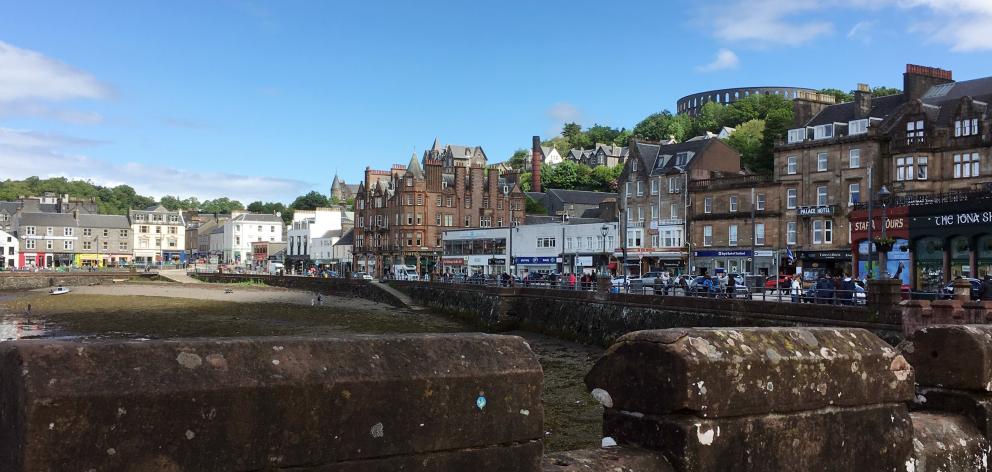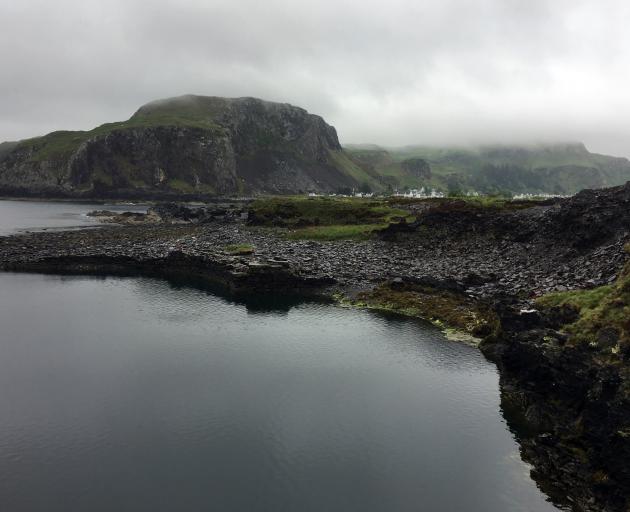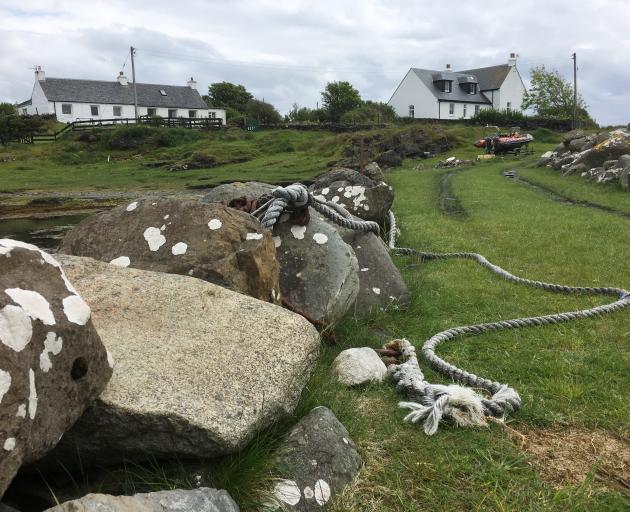
Headed for Oban, gateway to Scotland’s Western Isles, we left Glasgow on a frantic four-lane highway. Thankfully, it would be weeks before returning to roads like this.
We are, otherwise, spoilt for lochs as we continue along the bonnie banks of Loch Long, Loch Lomond, Loch Fyne and Loch Awe.
Arriving in Oban, we find our Georgian terraced Airbnb sits alongside the Roman Colosseum-inspired McCaigs Tower. Dominating Oban’s skyline, this 1897 edifice was built as a memorial to wealthy banker John McCaig and his family. Originally intended to contain a museum and gallery, unfinished, it is now grass and garden within. It’s an Italian oddity but at least the locally quarried Bonawe granite, for its two-tiered, lancet-arched form, blends in. From here, tree-top views of islands Kerrera, Lismore and Mull. Below, the efficient Calmac ferries skirr across the Firth of Lorn to the Hebridean islands beyond.

Sixteen kilometres south of Oban, the Slate Isles are first on our long island list.
To visit Seil we must cross the Atlantic — over Clachan Bridge, a single-arched humped-back masonry span designed for small ships to passage on the Clachan Sound. Sadly, Seil lost its island status in 2011 when the Scottish government, in a cost-cutting measure, concluded it was not an island, despite the bridge existing since 1792.

As we drive towards the village of Ellenabeich I think of Princess Diana, my 1980s role model; her mother, Frances, having lived and died here, aged 68, in 2004. I muse about where she might have lived. All the houses appear modest, mostly whitewashed, and, as I’m yet to realise, probably the nicest collection of bothies I will see my whole trip.
There’s a simple shelter on the pier that instructs us how to cross to Easdale: "The ferry can be summoned during operating hours by pressing both buttons for the klaxon and the light."

George shares the story of his son’s suicide and his mission to highlight mental health issues by way of swimming the blues. He wants to get out there the benefits of cold-water swimming. It’s difficult not to be inspired as we watch them plunge gently into an inky slate pool but as the wind whips in from the Atlantic, carrying with it the daily summer dose of salty rain, we retreat to the Puffer Cafe for the benefits of coffee and creel-caught langoustines.
Easdale is proud of its folk museum, capturing the history of slate, quarried and cut here, shipped as far as Canada and Australia. It was said the Slate Isles roofed the world. In 1794, 5 million slates annually were quarried on Easdale alone. The industry reached its peak in 1869 with an annual production of more than 10 million.

Ellenabeich village is the base to take a tour to the Corryvrekan Whirlpools. Unusual underwater topography, combined with the tide, creates a maelstrom. This occurs only about 30 days a year and, as good fortune would have it, two days of our visit.
Decked out in full wet-weather kit, we head out in Seafari’s rubber inflatables to the Corryvrekan Strait. Deemed a trip for the more adventurous, it involves two hours spent in open sea.
These waters off the Sound of Jura are regarded as violent and dangerous. Vessels are advised not to attempt passage without local knowledge.

Even a dispenser-machine hot chocolate tastes good after the udal cuain (being tossed about on the ocean).
It’s a short drive to North Cuan on the southern tip of Seil to take the ferry Belnahua to Luing (pronounced Ling). There’s a shed and honesty box at the camping ground, where we hire bikes to explore the 10km-long by 3.2km-wide eilean (gaelic for island).

The sun breaks out, the wind abates as we free-wheel down into Toberonochy. Lining the single road to the sheltered harbour there are houses with tubs of flowers, gardens and benches made from slate. We admire the pier, like an art installation, constructed from beautifully stacked vertical beach slate. Crayfish pots and an array of fishing gear indicate it’s still in use. Fishing, farming and tourism are now income sources for the 200 inhabitants.
Luing has its own cattle breed. Crossbreeding a Highland cow and beef shorthorn bull in 1947 resulted in a hardy and popular exportable breed. It was the first new British breed for more than 100 years and the Cadzow family continue to farm these dun-coloured beasts on the isle.

Heading southwest, we linger at Blackmill Bay, once the island’s hub for steamers bringing passengers and supplies. Sharing the beach with swans, oystercatchers and wheatears, there’s satisfaction in sifting through slivers of slate, pocketing a few. It’s really hard to get back on our bikes and leave the Scarba island view.
It’s been a day of being blown about, rained on and raw. It’s a Scottish summer after all, but no mind. These Scottish islands work their magic. These Scottish islands seep, they seep, into your soul.
- Julie Orr-Wilson












